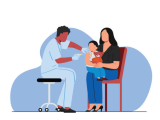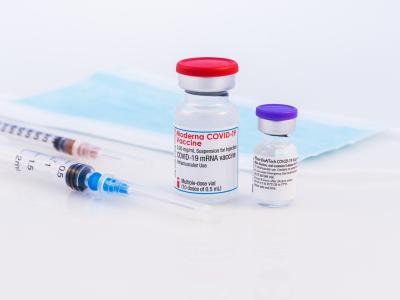Oct 18, 2002 (CIDRAP News) – The federal government's Advisory Committee on Immunization Practices (ACIP) amended its June 2002 recommendations on smallpox vaccinations for healthcare workers this week in an effort to ensure that the healthcare system will have enough immunized people to deal with a smallpox outbreak.
The committee called for immunizing emergency department and intensive care unit staff members, infectious disease physicians, respiratory therapists, dermatologists, and others who could be assigned to smallpox care teams in hospitals. The panel estimated that the number vaccinated could be an average of roughly 100 for each of the 5,100 acute-care hospitals in the nation, or a total of about 510,000.
The panel also concluded that healthcare workers will not need to take time off after being vaccinated, because the risk of transmitting vaccinia virus to patients is considered very low if the inoculation site is covered. Further, the committee said healthcare workers should not be vaccinated if they are pregnant, have a history of atopic dermatitis, or have HIV—all conditions that can lead to serious vaccine-related complications.
ACIP Chairman John F. Modlin, MD, and Walter Orenstein, MD, director of the National Immunization Program, discussed the committee's recommendations in a press briefing yesterday, following a 2-day ACIP meeting in Atlanta. Modlin said the Centers for Disease Control and Prevention (CDC) asked ACIP and the Hospital Infection Control Practices Advisory Committee (HICPAC) for advice on several smallpox immunization issues about a month ago, and the two committees had been working on them since then.
Last June, ACIP recommended that smallpox shots be given to healthcare workers assigned to smallpox response teams and to certain staff members in hospitals that were to be designated to take smallpox patients. The committee did not recommend smallpox immunization for all healthcare workers or the public. Modlin estimated at the time that roughly 10,000 to 20,000 workers would be vaccinated under the recommendation.
As Modlin and Orenstein explained them, the revised recommendations envision smallpox shots for some staff members in most hospitals, not just specially designated hospitals. The change apparently is a result of hospital officials' concern that their institutions will be stigmatized if they are designated to receive smallpox patients.
Modlin said the purpose of the expanded recommendations is not to set a target number of people to be immunized, but rather "to suggest that there be a sufficient number of healthcare workers in different categories . . . to provide care in many, if not most, of the acute-care hospitals in this country." He emphasized that the estimate of 100 workers per hospital is "very rough" and that the number will vary depending on how local public health agencies and the hospitals themselves assess their needs.
"The goal is a cadre of people who could care for the first several patients in the first 7 to 10 days on a 24-hour basis," said Orenstein, adding that the numbers will be determined mainly by the hospitals.
The CDC asked ACIP to clarify what types of workers should be on smallpox care teams in hospitals, Modlin said. The committee recommends that such teams include "emergency room physicians and nurses, intensive care unit staff, infectious disease specialists, medical personnel with smallpox experience, and other medical specialties, including dermatologists, pediatricians, ophthalmologists, pathologists, and surgeons," he said. "In addition, we recommend the smallpox healthcare teams include radiology technicians, respiratory therapists, proactive security and housekeeping personnel."
The committee also recommends "that hospitals establish at least two smallpox health care teams to ensure adequate care," Modlin said. "This is particularly true for acute-care hospitals that have airborne infection isolation rooms."
The panel also considered whether healthcare workers should be given administrative leave after being vaccinated, as was sometimes done in the past to prevent transmission of vaccinia to patients in their care. Modlin said the group concluded that "administrative leave is not required for newly vaccinated healthcare workers unless they are physically unable to work due to systemic signs and symptoms of illness or do not adhere to the recommended infection control precautions." He added that the "very close contact" that can result in transmission of vaccinia to household contacts is unlikely in hospitals.
In response to a question, Modlin cited current shortages of healthcare workers as the main reason for the recommendation against putting workers on leave. "We are faced with major shortages . . . that wind up being limiting factors in taking care of patients who are very sick," he said. ACIP felt that trying to coordinate time off for many workers would be difficult and could disrupt patient care and put patients at greater risk than would keeping workers on the job.
The advice against time off is tied to a recommendation that workers who care directly for patients keep their vaccination sites "covered with gauze or similar absorbent material in order to absorb exudates," Modlin said. He added that at least one layer of "impermeable occlusive dressing" should also be used.
Research has shown that the combination of gauze and an occlusive dressing substantially reduces the chance of finding virus outside the dressing, and "that formed the basis of the ACIP's conclusion that workers could work, as long as they had these kinds of dressings in place," said Orenstein.
Discussing contraindications to vaccination, Modlin and Orenstein said workers who have a history of eczema or atopic dermatitis or similar skin conditions, or share a household with someone who does, should not be vaccinated. When vaccinated for smallpox, people who have atopic dermatitis can suffer eczema vaccinatum, a severe rash that can sometimes be fatal.
Modlin said that from 7% to 17% of the population may have a history of atopic dermatitis, but the proportion of adults who "truly" have such a history may be only 2% to 5%. A history of another eczematous condition such as contact dermatitis entails less of a risk of vaccine complications than atopic dermatitis, but many clinicians do not readily distinguish between atopic dermatitis and other eczematous conditions, he said. To err on the side of caution, the committee recommends that people with eczematous skin conditions not be vaccinated unless they are sure the condition is not atopic dermatitis, he said.
Because of the risk of fetal vaccinia, which can lead to stillbirth, ACIP is also advising that women who are pregnant or trying to become pregnant not receive a smallpox shot. Before vaccination, women should be asked if they are pregnant or intending to get pregnant within 4 weeks, Modlin said. "However, routine pregnancy testing of women of child-bearing age was not recommended."
The committee advises against vaccination for people who have HIV or AIDS, given the risk of progressive vaccinia or vaccinia necrosum. Potential vaccinees should be told of the risk of complications for those with HIV or other immunosuppressive conditions, and those who think they may have such a condition should not be vaccinated, Modlin said. "The ACIP does not recommend mandatory HIV testing prior to smallpox vaccination, but recommends that HIV testing should be readily available to all persons considering smallpox vaccination."
In other recommendations outlined by Modlin, ACIP said:
- "Smallpox vaccine may be administered at the same time as any inactivated vaccine, including influenza vaccine." The vaccine may be given simultaneously with other live-virus vaccines, except for varicella (chicken pox).
- To prevent inadvertent inoculation and enhance preparedness, healthcare workers who administer smallpox vaccine should themselves be vaccinated first.
It was unclear from the briefing how soon immunizations of healthcare workers might begin or how the ACIP recommendations might influence the Bush administration's decisions on the shape of any smallpox immunization campaign. A White House decision on the issue, including whether to offer smallpox shots to the public, has been expected for several weeks.
Modlin said the HICPAC will be reviewing the ACIP's recommendations at a meeting Oct 22 and 23. "In coming weeks, the joint ACIP-HICPAC recommendations will be forwarded to CDC and DHHS [Department of Health and Human Services] for their review and consideration."
When asked how soon healthcare workers might be vaccinated, Orenstein said, "I think it depends on what the decision is, which will be made at the White House, and then how soon they feel it needs to be done regarding the national security interests."
In response to other questions, Modlin said the committee decided not to recommend smallpox shots for the nation's 800,000 emergency medical technicians in the first round of immunizations. The panel felt that the risk of smallpox exposure for EMTs would be low and that they are not high on the list of those who must be immunized to provide adequate care for hospitalized smallpox patients, he explained.
See also:
Transcript of ACIP press briefing
http://www.cdc.gov/media/transcripts/t021017.htm


















